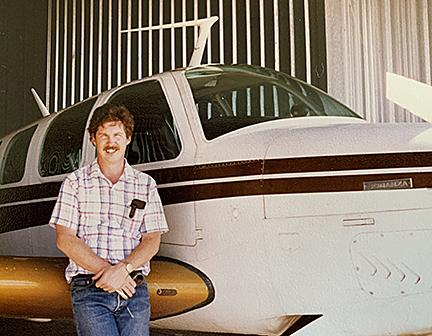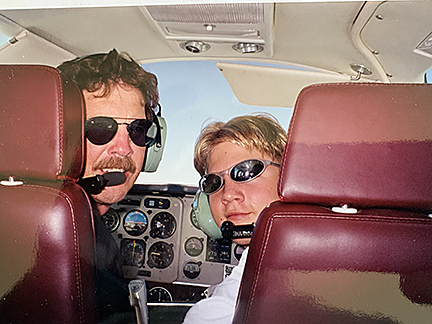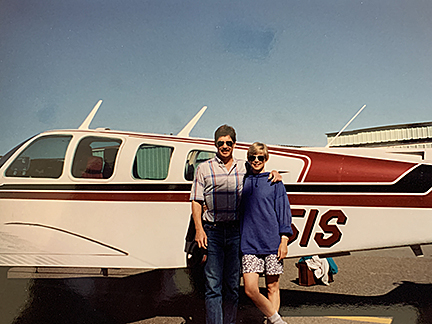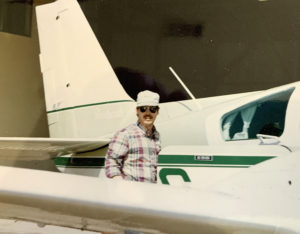John C. Eckalbar, Ph. D., ATP, CFI-I

BPT: John, as always, it’s great to talk with you! Tell me, what first attracted you to aviation – and why?
JE: My father was a Naval Aviator in WWII. He flew B24’s and PB4Y-2’s in the South Pacific island campaign. Later he flew for Northwest, then he worked for Boeing.
Thinking back on it now, it seemed like all the family friends were pilots. It was a great group. I listened to them talk as a kid and I wanted to be just like them. I tried to get into Navy flight school in 1970, but couldn’t pass the vision tests.
BPT: So where did you learn how to fly?
JE: I learned to fly in 1976 while in Canada on my first job as a university economics professor. It was a good time and place to learn. Lots of wind, ice on the runways, snow, whiteouts, airports few and far between, landing on roads to visit with farmers I knew, flying north to where there were no roads, no navaids, and the compass didn’t work. But there were lots of fish!
BPT: That’s incredible! Which aircraft have you flown?
JE: I bought a TR-2 in Canada and flew it all over — to New Orleans, Phoenix, Seattle. Then I moved to Chico, CA and bought an old straight 35 Bonanza. I wanted one ever since I took off in the TR-2 followed by Bonanza going in the same direction. Before I was a mile away from the airport, he passed me on the left 500’ higher and 80 kts faster. A beautiful sight.
After the 35, I found an airplane partner, Ray Luckel, and we bought a series of planes for many years. An early A36 came first, and it was a great improvement over the 35. Then an E-55 Baron, which is probably my favorite personal plane. Then back to a newer A36, which Ray still has. We even bought a Seneca to lease to a 135 business.
All this time I was adding ratings for instrument, commercial, multi, CFI-I, ATP and flying for a 135 outfit. I flew most of the Cessnas (through 404), Pipers, Beechcraft (through King Air). They got a contract with FedX, and I flew the Caravan in the FedX feeder system. I was also a pilot for ExecutiveJet (NetJets) and flew the Citation Ultra.
 BPT: Currently, what do you fly or own?
BPT: Currently, what do you fly or own?
JE: Currently, I’m between airplanes. I recently moved from Chico to Concord, CA and miss the partnership.
BPT: Looking back, what would you say are the highlights of your career in aviation so far?
JE: Highlights? There are a lot. (i) Lessons from my father. (ii) Any flight when you get there. (iii) Passing a checkride. (iv) Flying night cargo out of Oakland going north to Redding on a very rainy bouncy night at maybe 4:30 AM in an old Cessna 402.
I got soaked on the ramp. I was was cold, wet, tired and in a glum mood as I lifted off. No one else was talking on the radio. It was the kind of night where you call center with a dumb question just to see if there’s any one out there.
Looking outside, the position lights had halos, and all sorts of moisture was rushing over the wing. My eyes were scratchy. I closed them for a second and just rolled them around.
A second later I opened my eyes and was startled to see that I’d flown out into totally clear air in the midst of the storm. The clear area was circular with maybe a 20 mile radius. There was a full moon which illuminated some clouds going up to about 20,000 feet surrounding the clear area.
The clouds were bright and white on the edges, shading to gray in the moon shadow. A cloud canyon with stars on top. It was a stunningly beautiful sight that I’ll remember after I have forgotten everything else. I sat and stared. I’d stumbled into a holy place. My funky mood evaporated. Airplanes can do that.
 BPT: How did you become involved with BPT?
BPT: How did you become involved with BPT?
JE: John Frank invited me to teach in the 2nd ABS class in Oxnard in 1984. As I recall, the ground school was taught by John Frank, Ken Pearce, and Sam James. Frank heard that I was a professor and asked if I’d do a ground school lecture. I did. After that, it was Sam James, Bill Hale, Ken, and me for a long while.
BPT: Sounds as though BPT is very important to you. Why is that?
JE: Because I meet the most interesting people whenever I go.
The instructors are long term friends who generally are hyper-skilled in some non-flying activity, like engineering, medicine, aircraft maintenance, physics, or computer science. They have devoted themselves also to knowing as much as they can about flying safely in their Bonanzas, Barons, Dukes and sometimes King Airs.
Often, the students are also long-time friends, and they, too, are successful, interesting people who are highly motivated to learn more about flying their aircraft safely. They are a pleasure to teach.
 BPT: What do you think makes BPT unique?
BPT: What do you think makes BPT unique?
JE: The instructors. They have been together doing this for decades…watching each other’s classes, adding new topics, sharing notes on how to give a lesson on some flight procedure, sharing graphics that improve a lecture. That and much more.
BPT: Would you recommend BPT to a new pilot – and if so, why?
JE: I’ve seen so many new Bonanza owners just gobbling down every detail from ground school and flight training…talking to everybody, classmates included, saying: “Did you know this?” “Did your instructor show you that?” “Nobody ever told me that.”
BPT: How about to a seasoned pilot: would you recommend BPT? If so, why?
JE: There is a lot of effort made by instructors to get new lectures for the seasoned pilot. An amazing number have gone to the class for decades. Plus, seasoned or not, everyone needs refreshers and currency.



